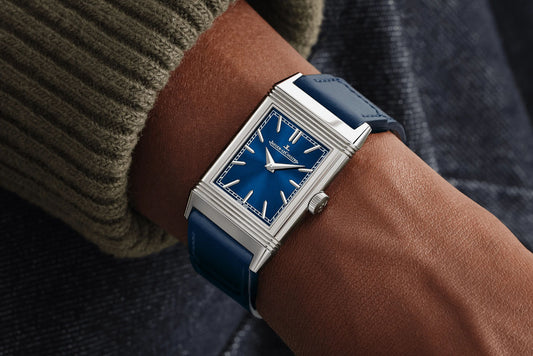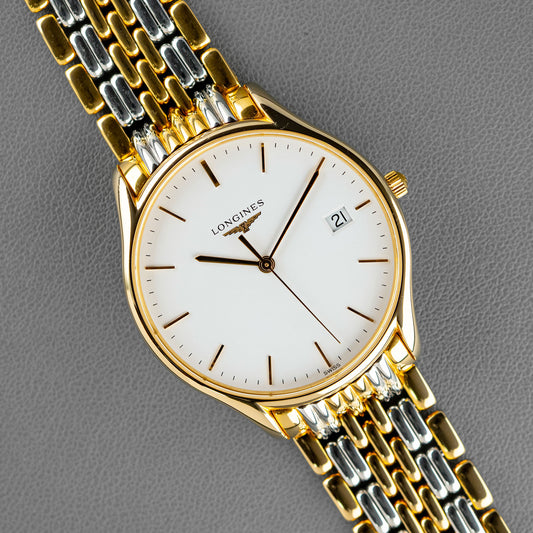Rolex Oyster Perpetual Deepsea Challenge, the diving watch that challenges limits
Fernando AldeaOn November 1, filmmaker and explorer James Cameron unveiled the Oyster Perpetual Deepsea Challenge. Inspired by the experimental timepiece that accompanied him during his historic dive on March 26, 2012, in the Mariana Trench (to –10,908 meters), the Deepsea Challenge marks a new milestone in the world of Rolex diving watches.
Guaranteed water-resistant to a depth of 11,000 meters, this RLX titanium watch is equipped with a helium valve and Ringlock system, and is capable of withstanding any type of immersion, whether in open water, submersible, or in a hyperbaric chamber. A watch designed to make pressure your ally in any circumstance and a call to expand the horizons of the depths a little further.
https://youtu.be/3GIx852sLRMAll Rolex savoir-faire at the service of an exceptional diver
The Deepsea Challenge, the ultimate deep-sea watch, is a true diver with unprecedented capabilities, designed to withstand extreme pressures. Meeting the watchmaking and industrial challenge of its creation required several years of research.
While the 2012 experimental watch was attached to the articulated arm of James Cameron's submarine, the Deepsea Challenge was designed to be worn on the wrist. From the construction of the case to the bracelet, everything was designed with everyday use in mind for this 50 mm diameter watch. A watchmaking feat made possible by the use of a grade 5 titanium alloy selected by Rolex: RLX titanium. Thanks to this robust and particularly lightweight metal, its weight was reduced by 30% compared to the 2012 experimental watch. To give the new watch ergonomic proportions and a harmonious aesthetic, certain components were modified; for example, the thickness of the crystal was reduced. The Deepsea Challenge is distinguished from other Professional watches by a particularly pronounced satin finish and polished lug edges. As for the bracelet extension systems—the Rolex Glidelock system and Fliplock plates—they allow the watch to be worn over a diving suit up to 7 mm thick.

James Cameron, wearing an Oyster Perpetual Deepsea Challenge on his wrist, poses with a model of the Trieste bathyscaphe, his submersible DEEPSEA CHALLENGER (center) and the two experimental watches attached to the vehicles during dives in the Mariana Trench: the Deep Sea Special (behind) and the Rolex Deepsea Challenge (front).
Credits: ©Rolex/Duncan Cole

Filmmaker and explorer James Cameron with the Oyster Perpetual Deepsea Challenge.
Credits: ©Rolex/Duncan Cole

In the foreground, from left to right: Oyster Perpetual Rolex Deepsea (2008), Oyster Perpetual Deepsea Challenge (2022), Deep Sea Special (1960), Rolex Deepsea Challenge (2012) and Oyster Perpetual Submariner (1986). In the background, from left to right: models of the DEEPSEA CHALLENGER submersible and the Trieste bathyscaphe.
Credits: ©Rolex/Duncan Cole

Credits: ©Rolex/Duncan Cole
The Deepsea Challenge represents all of Rolex's expertise in diving watches. It combines the major innovations developed by the manufacturer over many years: the Ringlock system, a patented case architecture that allows the watch to withstand extreme pressure; the helium valve, which serves to evacuate—during decompression phases in a hyperbaric chamber—excess internal pressure that could compromise the watch's integrity; the Triplock crown, with three water resistance zones; and the Chromalight display, distinguished by a long-lasting luminescent material that improves legibility. To test the water resistance of each Deepsea Challenge watch it produces, Rolex specifically developed, in collaboration with Comex (Compagnie Maritime d'Expertises), an ultra-high-pressure tank capable of exerting a test pressure equivalent to that found at a depth of 13,750 meters.
At the heart of the Oyster case is calibre 3230, entirely developed and manufactured by Rolex. A concentration of technology, this self-winding movement incorporates several patented elements: the Chronergy escapement and Parachrom hairspring, which are insensitive to magnetic fields, as well as Paraflex shock absorbers. Thanks to the architecture of its barrel and the superior performance of its escapement, calibre 3230 offers a power reserve of approximately 70 hours. Like all Rolex watches certified as a Superlative Chronometer, the Deepsea Challenge boasts chronometric precision within the range of -2/+2 seconds per day.
https://youtu.be/ow_papkKgm4A tribute to the explorers of the abyss

The Oyster Perpetual Deepsea Challenge, submersible to a depth of 11,000 meters (36,090 feet).
Credits: ©Rolex/JVA Studios

Detail of the beveled crystal of the Oyster Perpetual Deepsea Challenge.
Credits: ©Rolex/JVA Studios

The Oyster Perpetual Deepsea Challenge, waterproof to a depth of 11,000 meters (36,090 feet).
Credits: ©Rolex/Alain Costa

The Oyster Perpetual Deepsea Challenge, crafted from RLX titanium.
Credits: ©Rolex/Alain Costa

The Oysterlock clasp fitted to the Oyster Perpetual Deepsea Challenge with Rolex's Glidelock extension system and Fliplock extension link.
Credits: ©Rolex/Alain Costa

The Chromalight display of the Oyster Perpetual Deepsea Challenge, visible once the watch is plunged into darkness.
Credits: ©Rolex/Alain Costa
The Deepsea Challenge features the inscription "Mariana Trench" and the dates "23-01-1960" and "26-03-2012" engraved on the bottom. This is a tribute to two historic dives in the Mariana Trench: that of oceanographer Jacques Piccard and US Navy Lieutenant Don Walsh aboard the Trieste in 1960; and later, solo, that of James Cameron aboard the DEEPSEA CHALLENGER in 2012. Both expeditions wore experimental Rolex watches.
The design of the watch that accompanied James Cameron on his descent represented a major challenge in terms of size and time for the Rolex manufacturer. Tested to withstand a depth of 15,000 meters and a pressure of 17 tons on the crystal, this timepiece was developed in just a few weeks, thanks to the Rolex teams' extensive experience in deep-sea diving watches. During a seven-hour dive, three of them to the bottom of the abyss to record and collect samples, this experimental watch successfully withstood the colossal pressure, just as the 1960 watch did in its time.
Today, the Deepsea Challenge represents a new milestone in this human and technical adventure shared for decades by Rolex engineers and deep-sea explorers.

The engraved caseback of the Oyster Perpetual Deepsea Challenge.
Credits: ©Rolex/JVA Studios

Dot-dash-dot, the three marks that indicate that the winding crown of the Oyster Perpetual Deepsea Challenge is made of RLX titanium.
Credits: ©Rolex/Alain Costa
Rolex: Obsession with water resistance

The ultra-high-pressure tank developed in collaboration with Comex to test the waterproofing of the Oyster Perpetual Deepsea Challenge.
Credits: ©Rolex/Fred Merz

Oyster Perpetual Deepsea Challenge watches undergoing water resistance testing in a specially designed hyperbaric tank.
Credits: ©Rolex/Fred Merz

Decorative plaque on the Oyster Perpetual Deepsea Challenge's water resistance test chamber. It features the same engravings as the watch's caseback.
Credits: ©Rolex/Fred Merz

The middle case of the Oyster Perpetual Deepsea Challenge during the stamping process.
Credits: ©Rolex/Fred Merz

Manufacturing of the Oyster Perpetual Deepsea Challenge middle case in RLX titanium.
Credits: ©Rolex/Fred Merz
The issue of water resistance has been a fundamental pillar of Rolex's watchmaking expertise since its inception. Thus, in 1926, the Oyster case was born, completely watertight thanks to a system of bezel, crown, and caseback screwed into the middle. For almost a century, Rolex has perfected ever more efficient systems—Twinlock and Triplock crowns, and the Ringlock system—to protect the interior of its watches.
To meet the needs of diving professionals, Rolex began offering the Submariner in 1953, then guaranteed water-resistant to 100 meters, and today to 300 meters. In 1967, the brand launched the Sea-Dweller, a diving watch equipped with a helium valve and guaranteed water-resistant to a depth of 610 meters, and later to 1,220 meters. Presented in 2008, the Rolex Deepsea is a watch capable of meeting the challenge of great depths. With its Ringlock system, it can withstand the pressure prevailing at a depth of 3,900 meters.
The Oyster Perpetual Deepsea Challenge and its guaranteed water resistance to 11,000 meters open up new horizons in the great depths.







